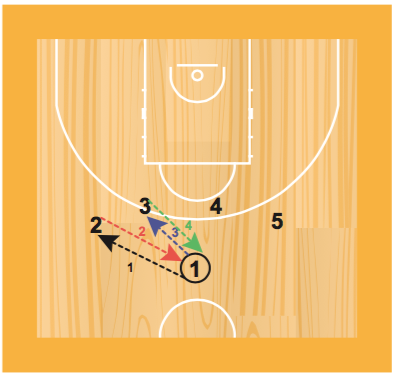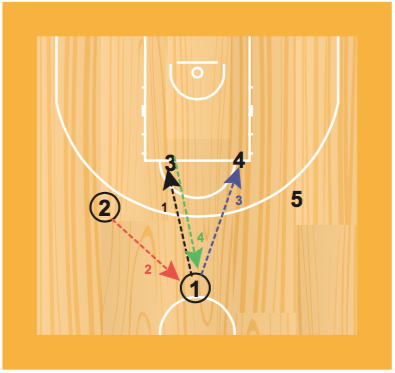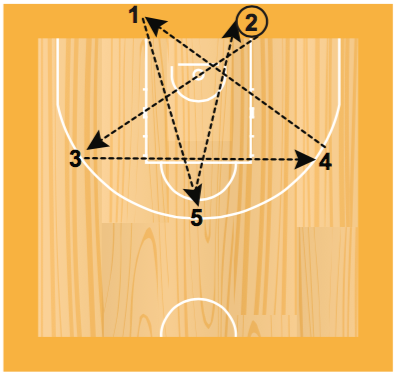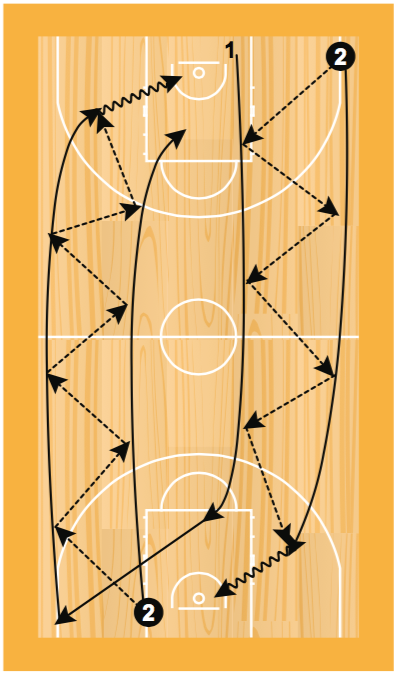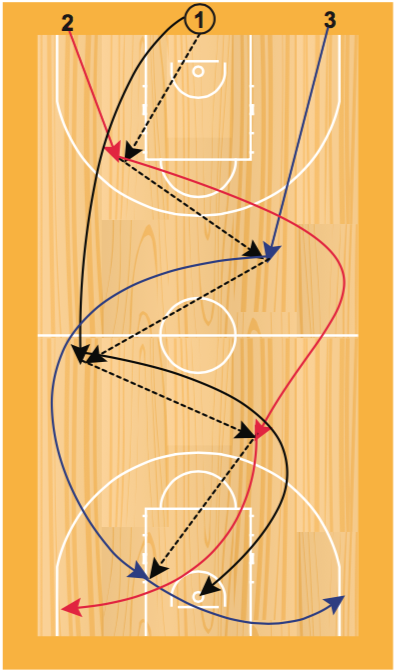Mini Basketball
4.4 Passing
Passing is one of the most important skills in a team game and teams that pass the ball well are hard to defend.
There are a number of “barriers” to young players passing the ball:
- they do not see their team mates (e.g. they are looking at the ball while dribbling)
- they cannot throw the ball far enough, when team mates are standing away from them
- they cannot pass past a defender (this is especially so when young players do not pivot properly and instead just turn their upper body).
- reduce the size of an area so that team mates are closer
- have more offensive players than defenders, so that it easier to see an open player
- do not allow dribbling (either at all, or until a certain number of passes have been made)
- do not let defenders take the ball away from a player, however they can intercept passes
- In pairs with one ball each, players exchange ball (standing, kneeling, sitting, lying on tummy). Progress to wrapping the ball in a “figure 8” around legs before exchanging balls.
- “Paris Passing”. Players are in pairs, with one ball for each pair. The person without the ball takes one or two steps away from their partner and then cuts back toward them to receive a pass. As they catch they must stop (coach can designate whether jump stop or stride stop) and pivot to face the basket. They then pivot to face their team mate to make a pass.
- Similar to Pairs Passing, players are in groups of up to 5. Count how many passes can be made in a set period of time, with a player not being able to pass back to the person that passed to them.
- In pairs, players run around a circle, passing the ball. On the coach’s signal they run in opposite direction.
- Divide players into two teams (one ball for each team) and line them up. The first in line rolls the ball between the legs of team members, and the last retrieves the ball and dribbles it to the front of in the line. Continue until the player that was initially at the front has returned to the front. The first team to have the player who began the game return to the front of the line first wins. The game can also be played with the players handing the ball to the player behind them turning their body sideways. This can be done both standing and sitting down.
- “Pepper Passing”. Players stand in a circle with a passer in the middle. The ball is passed from outside to the centre who then passes the ball to the next person on the outside. Teams can compete against each other to see who can pass around the circle quickest.
- “2 Ball Pepper Passing”. Same as the “Pepper Passing” drill except that two balls are passed back and forth.
- “Star Passing”. Players are in groups of 5 and are in a “Star” formation. On the coach’s signal they pass the ball in a set pattern and the team which makes the most passes in a set period of time wins
- “Star Lay-ups”. With groups of at least 6, each player “follows” their pass to stand behind the person that they passed to. 5 dribbles for a lay-up, which is rebounded by 2. After shooting 5 moves to the spot where 2 was.
- “Double Star Passing”. Similar to “Star Passing” but players are divided into two teams (and each team has a ball). The teams pass the ball at the same time.
- “Square Passing”. Players stand in a square, passing the ball between themselves as quickly as possible. On the coach’s signal they change the direction of the passes (clockwise and counterclockwise). The activity can also be done “on the move” with passers “following their pass” to join the line at the next corner.
- “2 Ball Square Passing”. Similar to the Square Passing activity, except that there are two balls, being passed in opposite directions. Again, on the coach’s signal, both balls must change direction.
- Players are in two lines (or in pairs) and pass the ball back and forth whilst running to the other end of the court. They may pass the ball the full length of the court, or when they get to the other end the player on the outside can take a shot. That player rebounds their own shot and the players then move to the other side of the court. The players swap lines on the way back.
- “Weaves”. Players are divided into 3 groups standing on the baseline with one ball. The person in the middle starts with the ball and passes to one of the outside players. They then sprint behind that person and move in front of them. As each player catches the ball the pass to a player on the opposite side coaches manual of the court and then run behind that player – creating a weave pattern. The Weave can either finish with a shot or by players stepping off the court at the other end. Weaves can also be done as “up and backs” with players running a designated number of full court sprints.
- Weaves can also be done with 4 groups (the first pass must always beto the side that has two players and is made to the closest player) or 5 groups (the first pass can go to the closest player either side and then sprint past both players on the side). In weaves with 4 or 5 groups, the pass is always to the closest person.
